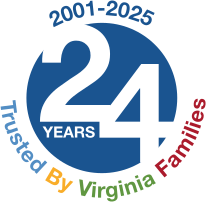Vehicle safety systems were created to protect adults. This causes children passengers to particularly be at risk during vehicle crashes or mishaps. Effective July 1, 2007 there were three changes to the Virginia Child Passenger Law. This law applies to anyone who provides transportation for a child in any vehicle manufactured after January 1, 1968.
- All children under age eight must be properly restrained in a child safety seat or booster seat.
- Rear-facing child safety seats must be secured in the back seat of a vehicle.
- Children can not ride unrestrained in the rear cargo area of a vehicle.
- Children are to ride in a rear-facing safety seat until the age of two or the child reaches the minimum weight limit for a forward-facing safety seat as prescribed by the manufacturer of the safety seat.
What Type of Safety Seat Should I Use? (Virginia Department of Health)
The safety seat used depends on the age, weight and height of the child. For more information on child passenger safety click here.
For more information on Virginia's Child Restraint Device Law provisions, click here.
In order for the safety seat to work properly, it must be installed correctly. Studies by the National Highway Transportation Safety Administration (NHTSA) have found over half of all safety seats are not used properly. Follow the manufacturer’s directions closely and visit a safety seat check station for assistance. For information on Safety Seat Checks click here.
GrandDriver is an educational resource designed to provide Virginians with information and resources about staying safe and mobile on the road as they age. GrandDriver is an initiative of the Virginia Department for Aging and Rehabilitative Services and is funded by the Virginia Department of Motor Vehicles.
